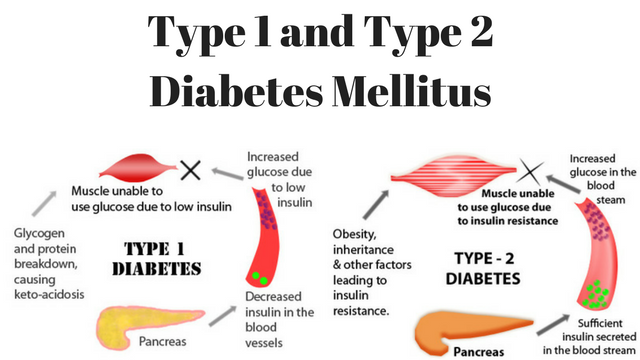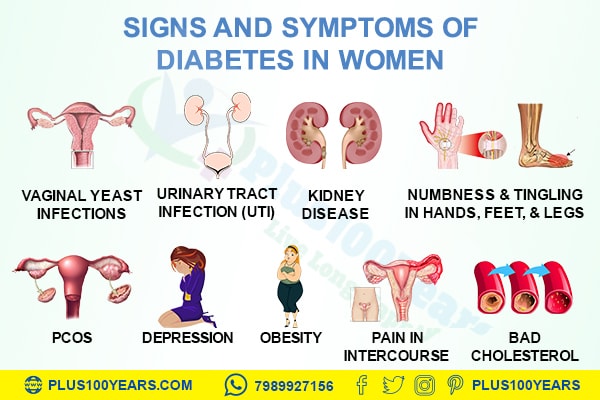
Diabetes is a chronic incurable disease that occurs when blood sugars levels are high. This happens because either the production of a hormone by the pancreas known as insulin is inadequate or the body’s cell does not respond appropriately to insulin or both. It is a serious complex condition, which affects the whole body.
There were an estimated 422 million adults that were diagnosed with diabetes from 2014 compared to 108 million that was reported in 1980 according to the global reports.
Diabetes is a metabolic disease, which can affect anyone irrespective of their age, gender, and lifestyle.
Types of Diabetes:

There are two main types of diabetes. They are type 1 and type 2 diabetes mellitus.
-
When the body’s immune system attacks insulin-producing cells from the pancreas and the body is unable to produce insulin. It is known as type 1 diabetes. It is an autoimmune condition, formerly known as juvenile diabetes.
-
Type 2 diabetes is a condition where cells cannot efficiently utilize blood sugar. This happens when blood sugar levels are high and the cells become insensitive to insulin.
Women with Diabetes
Between 1971 and 2000, a major achievement reflecting the many advances in diabetes treatment can be seen where the death rate for men with diabetes came down drastically according to a study.
However, there were no signs of improvement in the death rate for women with diabetes according to the study. Additionally, the difference in death rates more than doubled between women who had diabetes and those who did not.
Some of the reasons for the gender difference could be due to factors such as less aggressive treatment is provided to women for cardiovascular risk factors related to diabetes, difficulty in diagnosing the diabetic complications in women, women often experience different heart diseases than men, hormones act differently in women than in men.
These findings highlight how diabetes affects men and women differently.
Risk Factors for Diabetes in Women
The following factors put women at a high risk of developing type 2 diabetes:
-
Age above 45.
-
Overweight or obesity.
-
A family history of diabetes.
-
Women who are African-American, Native-American, Native Alaskan, Hispanic, Asian-American, or Native Hawaiian are more prone to be at high risk.
-
Previous child with a birth weight of more than 9 pounds.
-
Had gestational diabetes.
-
Have hypertension or high blood pressure.
-
Have hypercholesterolemia or high cholesterol.
-
Exercise less than 3 times a week.
-
History of heart disease or stroke.
{Also Read: Understanding How To Reverse Diabetes? }
Signs and Symptoms of Diabetes in Women

Most of the signs and symptoms of diabetes that are experienced are the same for both men and women. However, there are some symptoms that are unique to women. Some of those symptoms are:
-
Vaginal yeast infections, oral yeast infections, and oral thrush are witnessed because of an overgrowth of yeast caused by the candida fungus. Vaginal infections are accompanied by symptoms like soreness, itching, vaginal discharge and pain during sex.
-
When the infection is oral, a cottage cheese-like coating is seen on the tongue and the inside of the mouth. These infections are common in women.
-
Women who have diabetes are at a much higher risk of urinary tract infection (UTI). UTIs develop when bacteria enter the urinary tract. These infections can cause dysuria, a burning sensation, and bloody or cloudy urine. If left untreated, it could lead to the risk of a kidney infection.
-
Kidney disease is another complication of type 1 and type 2 diabetes that effects women more than men.
-
When high blood glucose damages nerve fibers diabetic neuropathy occurs. This triggers numbness and tingling in hands, feet, and legs. This condition may lower a woman’s sex drive by affecting the sensation in the vaginal area.
-
Polycystic ovary syndrome (PCOS) occurs when the adrenal gland produces a higher amount of male hormones. Signs of polycystic ovary syndrome (PCOS) are inclusive of irregular periods, weight gain, acne, and depression.
-
This also leads to infertility and a type of insulin resistance as a result of which, there is an elevation of blood sugar levels and an increased risk of developing diabetes.
-
It is noted that depression is noted to be more common in women with diabetes than amongst men with diabetes.
-
Poor blood sugar control leading to hyperglycemia and hypoglycemia, obesity, hypertension, hypercholesterolemia is more predominant in women with diabetes than men with diabetes.
-
There is a much higher risk of heart disease because of a drop in the HDL (“good”) cholesterol levels seen in women with diabetes.
-
Gestational diabetes occurs in women during pregnancy due to being obesity, family history of diabetes, previous gestational diabetes, stillbirth, or miscarriage, PCOS, etc. It is diagnosed between the 24th and 28th weeks of pregnancy. Gestational diabetes usually goes away after the baby’s birth.
Conclusion
A women’s body faces hurdles at all stages of life for managing diabetes and blood sugar. These hindrances may occur due to factors such as fluctuation of hormones associated with the menstrual cycle, childbearing, and menopause; birth control pills can cause an increase in blood glucose, yeast infections caused by glucose in the body, etc.
It is very important to be aware of the symptoms, to recognize it, to prevent and treat it at an early stage. A variety of medications are available that help in keeping diabetes in check.
Making healthy lifestyle choices like avoiding or quitting to smoke, eating and maintaining a healthy weight, eating a diet devoid of carbohydrates, and mainly focussing on fruits, vegetables, and whole grains, monitoring blood sugar at regular intervals, taking plant supplements, including broccoli, buckwheat, peas, etc.
To the diet, regular consultation with healthcare professionals, etc. is essential in playing a vital role in the management of symptoms of diabetes. Once diagnosed with diabetes, it is incurable and only its symptoms can be managed. With the help of appropriate symptom management, overall health can be improved.
"we would greatly appreciate it if you kindly give me some feedback on this article"

Add new comment